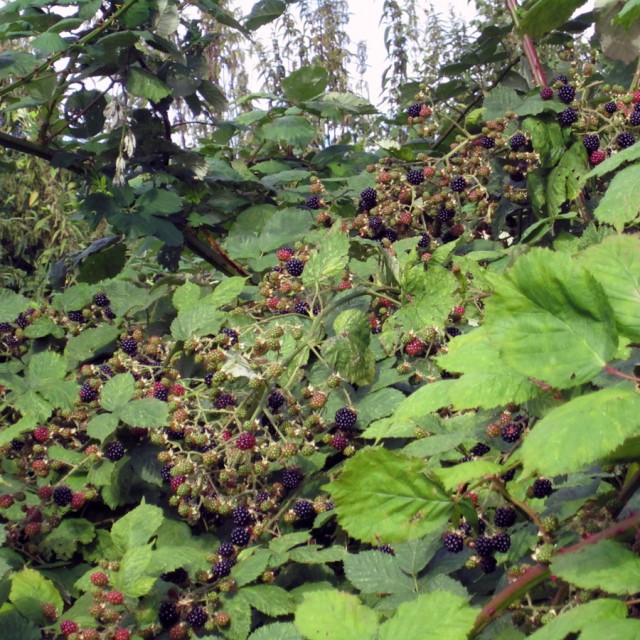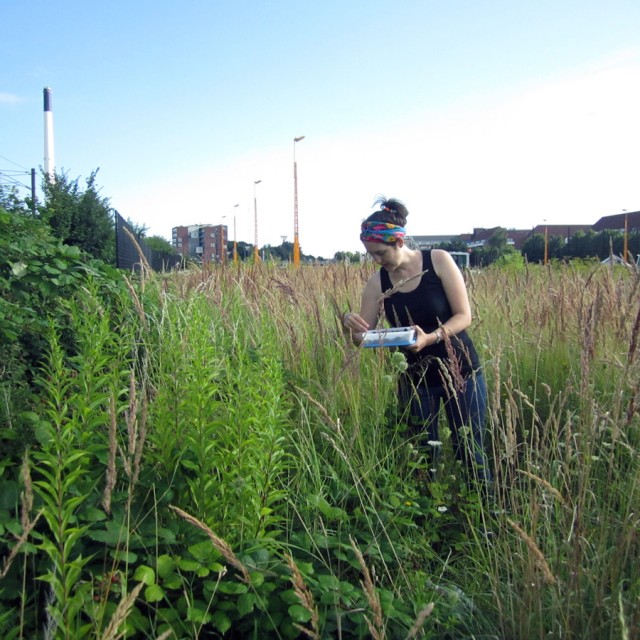Søndag brombær / Sunday blackberries
We spent some time this morning gathering blackberries in a favorite spot of ours in an empty lot near our apartment. It seems as though the berries were late to ripen this year. However, they are in incredible abundance, which also seems different from last year. We spent a little less than an hour collecting berries, some to eat today, and more to freeze for the winter. We made no clear visual impact on the bushes. You would not have been able to tell we had picked anything because there were so many berries left.
These brambles, easily twice our heights in some places, are on land contiguous with some that is being turned into yet another soccer-field-playground-place-to-get-drunk-and-be-stupid-park, which while it is much needed in our densely packed ‘hood, it is also sad that the vision of what constitutes a public outdoor space is so limited, bureaucratic and outright boring. Copenhagen desperately needs more healing green spaces that are for animals and plants, and a functioning, natural watershed, as much as they are for people. There need to be more spaces for reflecting and communing with nature, eating things you pick yourself that don’t come from stores, and simply being able to go somewhere that is not just an analog for your TV or indoor space, being able to disappear from the dirty, congested city if only in your mind for a short period. In a city that fantasizes itself one of the “greenest” (with deeply flawed fantasies of carbon neutrality in the future – more about this in a later post) in the world, why are there no foraging forests to walk through? Why are there not conversations about food resilience in the city? I am sure they happen on a micro-level amongst informed folks, but they are not happening on a mass level and this is troubling and shortsighted and shows the city is not at the forefront of the conversations happening in other places.
Despite our frustration with the lack of ecological leadership on the municipal level, and the profoundly dull “green” spaces we are handed, we are heartened by our modest harvest of wild berries. The blackberries have found a way to thrive in the cracks of control and droll city building. We thank them for their tenacious and successful resistance. They inspire us to be more like blackberries in how we think our presence in this city.
Radio Aktiv Sonic Deep Map (2013)

SUPERKILEN – Extreme Neoliberalism Copenhagen Style

Read Brett's essay about the park.
Download our guide:

This is our guide to how-to books from the counterculture of the 60s and 70s. Click to get the download page.
Categories
- Agriculture (11)
- Animal sounds (1)
- Artist parents (19)
- Arts and culture (106)
- Bees (3)
- Book reviews (14)
- Books (18)
- Critical essays (5)
- Daily Photo (5)
- Design (36)
- Dirt (11)
- Environmental activism (43)
- Exhibitions (24)
- Farms (11)
- Forest (7)
- Friday connect (15)
- Growing (42)
- Habitat (38)
- Homesteading (16)
- Interviews (15)
- Kitchen (14)
- Living structure (9)
- MISC (15)
- Mythological (2)
- Neighborhood (83)
- Ocean News (1)
- Our Art Work (21)
- Personal – Design/Art (3)
- Play (2)
- Playground (4)
- Projects (21)
- Public space (53)
- Resilience (13)
- Sea Side (2)
- Sojabønner (2)
- Tofu (8)
- Vermont correspondence (7)
- Water (3)
- Wednesday picture (31)
- Workshop (1)
Video interview:

Watch our interview of SeedBroadcast, a mobile project that is part seed library and part seed-saving-story-collecting machine-recording the stories of seed saving, farming, and food sovereignty work being done around the US.

Download a poster Bonnie made about biodiversity in a vacant lot in the Amager borough of Copenhagen, in collaboration with biologist, Inger Kærgaard, ornithologist, Jørn Lennart Larsen and botanist, Camilla Sønderberg Brok: A BRIEF TAXONOMY OF A LOT

We made and installed a network of bat houses in Urbana, Illinois, to support the local and regional bat population, but also to begin a conversation about re-making the built environment.
READ MORE
BOOK REVIEW:

We write often about artists and art groups that work with putting ‘culture’ back in agriculture. Here is a new favorite: myvillages, a group of three women based in Germany, the Netherlands, and the UK. Read more...

Post Revolutionary Exercises
We really admire the dedicated hard work of Kultivator who seeks to fuse agriculture and art in their work. Click this sentence to get a PDF of their poster collection called "Post Revolutionary Exercises."

Cultural Practices Within And Across
This amazing book networks urban and rural resilience and sustainability projects around the world. Deeply inspiring projects in Romania, Paris, San Francisco, and elsewhere.
• Read our review of the book.
• Buy the book.
• Download the book.










